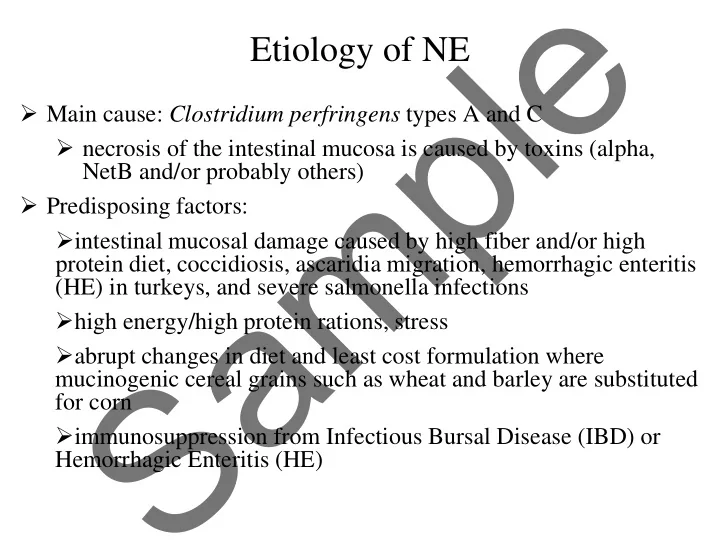

e l Etiology of NE p Main cause: Clostridium perfringens types A and C necrosis of the intestinal mucosa is caused by toxins (alpha, m NetB and/or probably others) Predisposing factors: intestinal mucosal damage caused by high fiber and/or high protein diet, coccidiosis, ascaridia migration, hemorrhagic enteritis a (HE) in turkeys, and severe salmonella infections high energy/high protein rations, stress S abrupt changes in diet and least cost formulation where mucinogenic cereal grains such as wheat and barley are substituted for corn immunosuppression from Infectious Bursal Disease (IBD) or Hemorrhagic Enteritis (HE)
e l Clinical Signs of NE p m Clinical signs are mostly non-specific such as anorexia, severe depression, reluctance to move, and ruffled feathers Rapid increase in mortality is commonly observed a S
e l Gross Lesions of NE p Distended and friable mid-small intestine, ceca can be involved m occasionally Foul-smelling brown-colored intestinal contents Intestinal mucosa covered by brownish diphtheritic membrane that looks like a “Terri-cloth” (referred to in older literature as a a “Turkish towel” appearance) Multifocal, well circumscribed, tan colored lesions in the liver; S these lesions are pinpoint and larger, often coalescing, in chickens and turkeys. Intestine can be distended with increased mucus in acute stages and in subclinical cases of NE
e l Microscopic Lesions of NE p Characterized primarily by severe necrosis of the intestinal mucosa m with an abundance of fibrin mixed with cellular debris Occasionally deep ulcers can be seen Numerous large Gram-positive usually bacilli typically lacking a a terminal spore are often observed attached to the tips of the villi or in the lamina propria mixed with cellular debris S
e l p m a S Slide 3. Necrotic Enteritis – small intestine, chicken
e l p m a S Slide 4. Necrotic Enteritis – turkey intestines
e l p m a S Slide 5. Necrotic Enteritis – turkey intestines
e l p m a S Slide 6. Necrotic Enteritis – H&E section; Chicken intestine
Recommend
More recommend